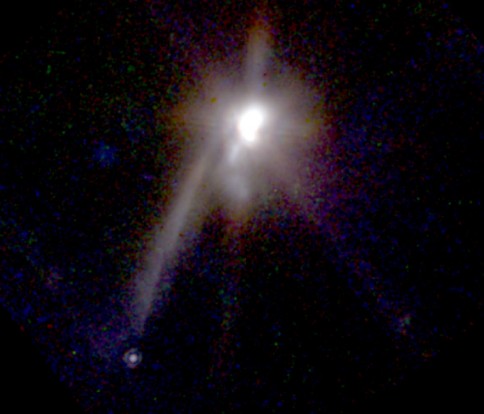Credit & Copyright: S. Terebey
Extrasolar Research Corp.,
NASA
Explanation:
This infrared Hubble Space Telescope view may contain the first ever
direct image of a planet outside our own solar system.
The picture shows a very
young double star located about 450
light-years away toward
the constellation of Taurus.
Cataloged as TMR-1 (Taurus Molecular Ring star 1),
the binary system is still
embedded in the dust cloud that formed it.
This double star and dust cloud are the brightest grouping in
the picture, glowing strongly at infrared wavelengths.
A filament extends from the binary system toward the lower left and
points toward the spot of light representing the
candidate planet.
Astronomers believe this
planet is a "runaway" object which was
gravitationally ejected, the filament tracing the path to its present
location at about 1500 times
the Earth-Sun distance from the parent star system.
Models suggest that the planet and
binary system are
a mere 300,000 years old, with the
planet having a mass of about 2 to 3 Jupiters.
Future observations to look for the planet's
continued runaway motion
and spectral signatures should be able to confirm
the nature of this object.
While this and other
tantalizing discoveries of
extrasolar planetary objects and
protoplanetary disks
don't seem to offer direct
examples of solar systems
like our own, they do strongly hint
that planet formation is a varied and common process.
Update:
TMR-1 likely just a background star.
1999 2000 2001 2002 2003 2004 2005 2006 2007 2008 2009 2010 2011 2012 2013 2014 2015 2016 2017 2018 2019 2020 2021 2022 2023 2024 2025 |
Январь Февраль Март Апрель Май Июнь Июль Август Сентябрь Октябрь Ноябрь Декабрь |
NASA Web Site Statements, Warnings, and Disclaimers
NASA Official: Jay Norris. Specific rights apply.
A service of: LHEA at NASA / GSFC
& Michigan Tech. U.
|
Публикации с ключевыми словами:
extrasolar planet - planet formation - пылевой диск - Протопланетные диски - Планеты у других звезд - двойные системы
Публикации со словами: extrasolar planet - planet formation - пылевой диск - Протопланетные диски - Планеты у других звезд - двойные системы | |
См. также:
Все публикации на ту же тему >> | |
